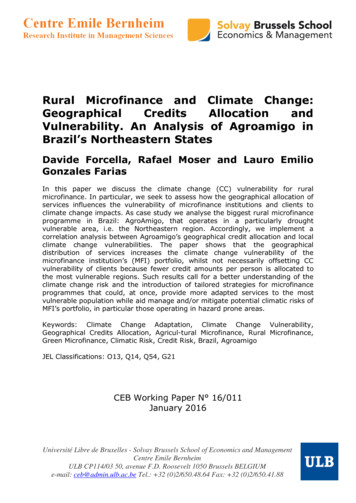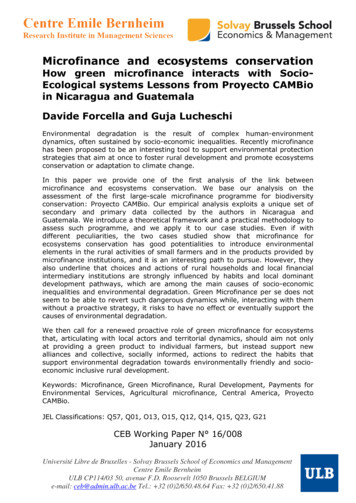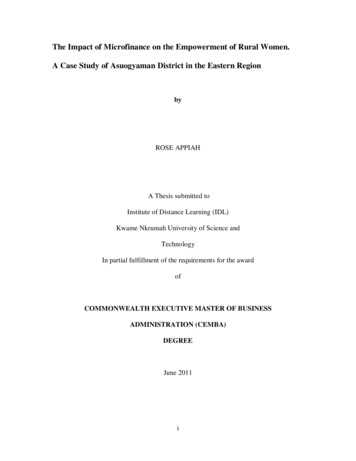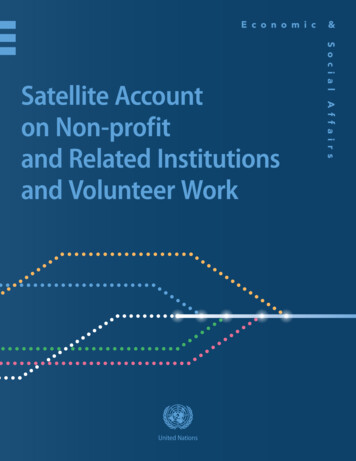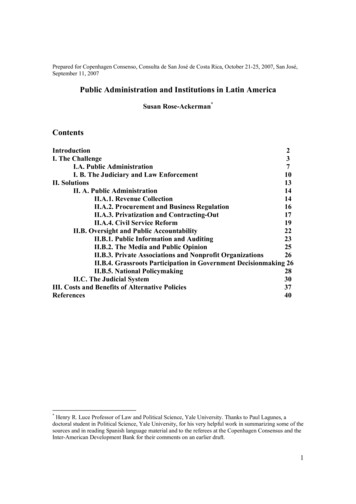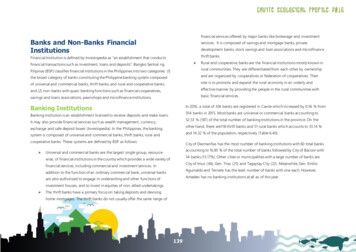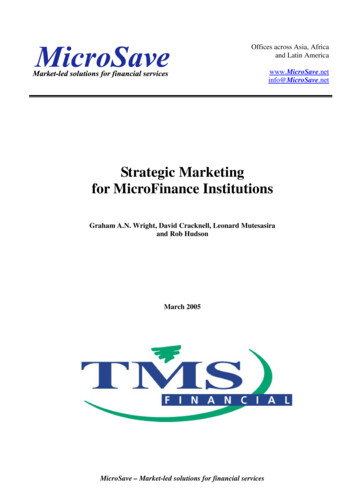
Transcription
Offices across Asia, Africaand Latin c Marketingfor MicroFinance InstitutionsGraham A.N. Wright, David Cracknell, Leonard Mutesasiraand Rob HudsonMarch 2005MicroSave – Market-led solutions for financial services
Strategic Marketing for MicroFinance Institutions - Graham A.N. Wright, David Cracknell, Leonard Mutesasira and Rob Hudson1Strategic Marketing for MicroFinance InstitutionsGraham A.N. Wright, David Cracknell, Leonard Mutesasira and Rob Hudson“As more players enter the market and competition increases, microfinance will inevitably move awayfrom the supply-led approach that applied a narrow range of lending methodologies to a wide range ofcontexts, towards a demand-driven, client-oriented approach.”- CGAP Phase III Strategy 2003-2008Introduction:Microfinance has demonstrated its potential to assist the poor to make significant strides towardsreducing their vulnerability, improving their livelihoods, paying for basic health care and financing theirchildren’s education (Littlefield et al., 2003). Many microfinance Institutions (MFIs) have demonstratedan ability to provide financial services to poor people on a sustainable, profitable basis. Together, thesefacts have attracted a great deal of donor of money and a wide variety of organisations into theMicrofinance sector. As a result, a growing number of markets are becoming extremely competitive andclients have an ever-widening choice of financial service providers to choose from. With the vastmajority of MFIs functionally confined to offering short-term credit products, the clients are effectivelygiven the choice of staying with or leaving their current service provider at the end of every loan cycle. Incompetitive markets they are exercising this choice with unflinching regularity . and many are“deserting” their service provider to try another or simply to take a “rest” from the rigours of MFIs’ termsand conditions.The extensive literature documenting the reasons for and cost to MFIs of high levels of “drop-out”, “exit”or “desertion” (see for example Hulme et al., 1999, Wright 2000, Brand and Gershick, 2000) has spurredthem to re-examine their products and delivery systems to respond better to clients’ needs. Furthermore,the growth in competition between MFIs in many markets has meant that growing numbers of MFIs areresponding by seeking to better understand their clients’ demands and preferences and thus taking amarket-led approach to their business (Anyango, Sebtsad and Cohen, 2002).The development of a more client-responsive, market-led approach to Microfinance is an importantwatershed in an industry hitherto largely dominated by the misconception that simple replication ofsuccessful models could achieve massive and sustainable scale worldwide. As Hulme notes, “Ironically itis the success of the “first wave” finance for the poor schemes that is the greatest obstacle to futureexperimentation” (Hulme, 1995 quoted in Rogaly, 1996).For most MFIs responding to the market has been largely in terms of developing new products that meetthe needs of their clients. But some others are beginning to move towards a strategic marketing approachthat looks at corporate branding and identity as well as product delivery system and customer servicestrategies in addition to the product strategy.There are many benefits in doing this for both the MFIs and their clients. For the MFI a market-ledapproach enhances customer loyalty and reduces drop-outs and thus increases profitability (Churchill andHalpern, 2001). For the MFIs’ customers more appropriate, client-responsive products allow them tobetter manage their household finances with a variety of financial services and products, in which theyhave confidence, delivered through systems and people that are secure, efficient and satisfying.MicroSave – Market-led solutions for financial services
Strategic Marketing for MicroFinance Institutions - Graham A.N. Wright, David Cracknell, Leonard Mutesasira and Rob Hudson2Why a Market Orientation?Extracted from Gary Woller, 2002“Market orientation holds that “success will come to those organizations that best determine theperceptions, needs, and wants of target markets and satisfies them through the design, communication,pricing, and delivery of appropriate and competitively viable offerings.”1 In contrast to a marketorientation, most MFIs possess a “product orientation,” which holds that “success will come to thoseorganizations that bring to market goods and services they are convinced will be good for the public.”2The transition from product orientation to market orientation is a process that has occurred in virtually allmature industries. The microfinance industry is unique only in that it relatively young and immature, andit has yet to pass through this phase. But pass through this phase it must, if it is to survive and prosper.The question for MFIs is how to take an abstract concept like market orientation and give it realmanagerial/operational relevance.Of 48 studies testing the relationship between market orientation and institutional performance, 44 foundpositive relationship between market orientation and at least one measure of institutional performance asmeasured by profitability, sales, market share, or innovation success. The same studies also foundpositive relationships between market orientation and other organizational variables, such as customerretention, customer service, esprit de corps, trust in senior management, job satisfaction, and the intent toremain at an institution. The weight of these empirical findings offers conclusive evidence that higherlevels of market orientation lead generally to higher levels of institutional performance.Implications for MicrofinanceThe implications of the market orientation research for MFIs are many: Market orientation is by extension an important determinant of MFI performance (e.g., financial selfsufficiency, revenue growth, customer desertion, repayment rates, etc.) The best way to achieve long-term financial self-sufficiency and achieve deep outreach is to identifythe needs and wants of the very poor and to provide products of value to them. To the extent MFIs explicitly target the very poor and create learning institutions in tune with theirneeds and wants, competition and the drive for sustainable competitive advantage will drive MFIs tofind ways to serve the very poor in an increasingly cost-effective manner. The creation of a market-oriented institutional culture and market-oriented institutional practices isthe distinct responsibility of senior management. Without the explicit and active participation ofmanagement (in both word and deed), the transition to market orientation will fail. The creation of an appropriate customer-centered reward system is an integral component of thetransition to market orientation. It is an unambiguous statement of managerial values that connectrhetoric to practice. Other market-oriented practices include monitoring customer satisfaction and otherwise routinelysoliciting customer feedback, hiring staff with customer-centered attitudes and firing those without,increase interaction and decrease conflict between functional departments, or pushing the decisionmaking locus closer to the customer.”The microfinance industry is beginning to mature, and with maturity comes change. There are fouralternative concepts on which organisations conduct their activities – these represent the development ofmarketing philosophy. The concepts have characterised the maturation of most industries over time, andare also clearly discernable in the microfinance industry. The process of maturation has typically (but notalways) been linear with the industry passing through each phase before moving to the next. Theseconcepts for organisational activities are: Production: which focuses on producing goods/services as cheaply as possible; Product: which focuses on making the goods/services as high quality as possible;12Kotler, P. and Andreasen, A.R. (1996)Kotler P. and Andreasen A.R., (1996)MicroSave – Market-led solutions for financial services
Strategic Marketing for MicroFinance Institutions - Graham A.N. Wright, David Cracknell, Leonard Mutesasira and Rob Hudson3 Selling: which focuses on persuading potential customers to buy the goods/services beingproduced; and Marketing: which focuses on understanding the target market(s) needs and responding to thesein all aspects of the organisation’s operations.Table 1. Development of Marketing PhilosophyD ev elo p m e n t O f M a r k etin g P h ilo so p h yM a rk etin gc o ncep tC U S T O M E R D R IV E NS e llin g co nc ep ttim eP ro d uc t co n cep tP ro d uc tio nc o ncep tP R O D U C T D R IV E NThe marketing concept takes an outside-in perspective. The organisation tries to see itself from theclient’s perspective, and base its decisions (subject to financial and organisational constraints) on thisperspective.Organisations using the marketing concept recognise that there is more value in retaining customers thanin attracting new customers who cost more. This concept works more at identifying and meetingcustomers’ needs profitably in addition to maximising customer satisfaction with existing products.Background to the Study:MicroSave reviewed the marketing strategies of eight diverse Action Research Partners (ARPs) incollaboration with TMS Financial a marketing company based in South Africa. These ARPs include awide variety of organisations: NGO-MFIs (FINCA-Uganda and Uganda Microfinance Union) Commercial banks (Centenary Rural Development Bank and Teba Bank) Government owned financial institutions (Kenya Post Office Savings Bank and Tanzania PostalBank) Non-bank financial institutions (Equity Building Society and Credit Indemnity).This diversity allowed the reviewers to gain significant insights into generic issues facing the industry.The reviews looked at all aspects of the ARPs’ marketing strategies using marketing defined in itsbroadest terms – see “Strategic Marketing Defined” Box belowStrategic Marketing – Defined“Marketing attempts to understand the needs of the client and to adapt operations in order to meet thoseneeds and achieve greater sustainability. It addresses the issues of new product development, pricing, thelocation of operations and the promotion of the institution and its products. Marketing is acomprehensive field aimed at strengthening the institution by maintaining focus on the client. In doingso, it creates exchanges that satisfy individual and organisational goals.”Kotler, 1999MicroSave – Market-led solutions for financial services
Strategic Marketing for MicroFinance Institutions - Graham A.N. Wright, David Cracknell, Leonard Mutesasira and Rob Hudson4The Results of the Study:Need for Marketing FunctionThe top management within all eight ARPs reviewed appreciated the need for and value of the marketingfunction within their organisations and noted that “future profitable survival would be dependent on themarketing effectiveness of the organisation ” . “The ever increasing competitive nature of the microfinance / banking environment widely attributed as the primary driver of this need” (Hudson andMutesasira, 2002).Importance and Role of Marketing Strategy and PlanThe South Africa-based ARPs were noticeably more sophisticated from a strategic marketingperspective, but only one of the eight ARPs had a formalised marketing strategy and plan – this is nowbeing addressed by most of the organisations. The report noted “the importance of formal planning inassociation with strategy development and particularly implementation. Plans serve as the road map todelivering against strategic objectives and optimise process consistency, timing, co-ordination,momentum and overall control” (Hudson and Mutesasira, 2002).Evolution of the Marketing FunctionThe marketing function of the ARPs reviewed had evolved from market research activities initiated eitherto examine client satisfaction and/or to develop new products. As the MFIs grew to understand more ofthe determinants of client satisfaction and successful products, so the role of the marketing functionbegan to expand to take on customer service, promotion and selling and delivery systems, as well as (inthe more sophisticated MFIs) corporate branding and identity.Customer Service in MarketingCustomer service is a key determinant of client satisfaction and loyalty. It is one of the aspects of MFIoperations that is relatively easy and low-cost to improve upon. And yet few MFIs have focused onunderstanding and improving customer service in a systematic manner. “Research undertaken by SouthAfrican MFIs highlights the extensive influence of the word of mouth effect on generating sales. In EastAfrica the top management of MFIs reviewed all appreciate the reliance of word of mouth promotion onsales and as such most endeavour to achieve differentiation through customer service performance. Yetfew of these players had any formal customer service strategy or staff training policy at time of review”(Hudson and Mutesasira, 2002).Management Information Systems (MIS)Prior to undertaking field-based primary research, MFIs need to use the secondary data sources availableto them. A good MIS can provide large amounts of valuable strategic marketing information – at farlower cost than conducting primary market research. “More and more strategic marketers areappreciating and exploiting the value of internally generated market intelligence. Intelligence of thisnature has diverse strategic value supporting strategic decision making in areas such as the identificationof: Product cross selling, growth and innovation opportunities within the client base; Market segmentations requirements; Product profitability trends; Profitability trends by market segments, regions, profiles etc.; and Risk related trends by market segments, regions, profiles etc.The extent and value of
Strategic Marketing for MicroFinance Institutions - Graham A.N. Wright, David Cracknell, Leonard Mutesasira and Rob Hudson MicroSave – Market-led solutions for financial services 3 Selling: which focuses on persuading potential customers to buy the goods/services being produced; and Marketing: which focuses on understanding the target market(s) needs and responding to these


